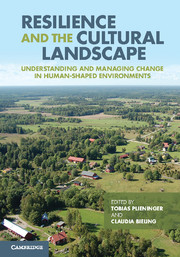 Resilience and the Cultural Landscape
Resilience and the Cultural Landscape Book contents
- Frontmatter
- Contents
- List of contributors
- Preface
- Part I Conceptualising landscapes as social–ecological systems
- Part II Analysing landscape resilience
- 7 In search of resilient behaviour: using the driving forces framework to study cultural landscapes
- 8 Cultural landscapes as complex adaptive systems: the cases of northern Spain and northern Argentina
- 9 Linking path dependency and resilience for the analysis of landscape development
- 10 The sugar-cane landscape of the Caribbean islands: resilience, adaptation and transformation of the plantation social–ecological system
- 11 Offshore wind farming on Germany’s North Sea coast: tracing regime shifts across scales
- Part III Managing landscapes for resilience
- Part IV Perspectives for resilient landscapes
- Index
- References
8 - Cultural landscapes as complex adaptive systems: the cases of northern Spain and northern Argentina
Published online by Cambridge University Press: 05 November 2012
- Frontmatter
- Contents
- List of contributors
- Preface
- Part I Conceptualising landscapes as social–ecological systems
- Part II Analysing landscape resilience
- 7 In search of resilient behaviour: using the driving forces framework to study cultural landscapes
- 8 Cultural landscapes as complex adaptive systems: the cases of northern Spain and northern Argentina
- 9 Linking path dependency and resilience for the analysis of landscape development
- 10 The sugar-cane landscape of the Caribbean islands: resilience, adaptation and transformation of the plantation social–ecological system
- 11 Offshore wind farming on Germany’s North Sea coast: tracing regime shifts across scales
- Part III Managing landscapes for resilience
- Part IV Perspectives for resilient landscapes
- Index
- References
Summary
Introduction
Traditionally, numerous studies that analysed the impact of human activities on ecosystems conceptualised humans either as external drivers of ecosystems (albeit not influenced by them) or as users of the environment (but not influencing it). However, in recent years, studies have changed their focus on the interdependency between social systems and ecosystems (Gunderson & Holling, 2002; Holling, 2001). In this sense, Farina (2000) highlights cultural landscapes as human land use systems shaped by the intricate relationship between social and ecological systems. They are the result of a slow co-evolution of both systems and they have taken centuries to reach their current configuration, reflecting a mutual adaptation of abiotic, biotic and cultural factors.
Here, we argue that complexity theory offers new opportunities for conceptual and theoretical development when cultural landscapes are considered as complex adaptive social–ecological systems (Liu et al., 2007; Rescia et al., 2010; Walker et al., 2004). Complex adaptive systems are characterised by cross-scale non-linear interactions and feedback loops between the ecological and socioeconomic components and they present stable dynamics characterised by three complementary attributes: resilience, transformability and adaptability (Walker et al., 2004). In many studies, the concept of resilience has been seen as the capacity to withstand or recover from disturbance, while still essentially retaining the same function, structure, identity and interconnections (Walker et al., 2004). In cultural landscapes, resilience is considered as the capacity for transformation and adaptation of the population and their activities (i.e. land use system) and ecosystems in the face of gradual changes in socioeconomic conditions and biophysical characteristics, until these cross certain thresholds (Berkes & Folke, 1998; Holling, 2001). In a normative sense, resilience of cultural landscapes ensures the flows of services they supply, such as cultural identity, heritage value, recreation and tourism, land use diversity, biodiversity and carbon sequestration (Oteros-Rozas et al., Chapter 14).
- Type
- Chapter
- Information
- Resilience and the Cultural LandscapeUnderstanding and Managing Change in Human-Shaped Environments, pp. 126 - 145Publisher: Cambridge University PressPrint publication year: 2012
References
- 7
- Cited by


